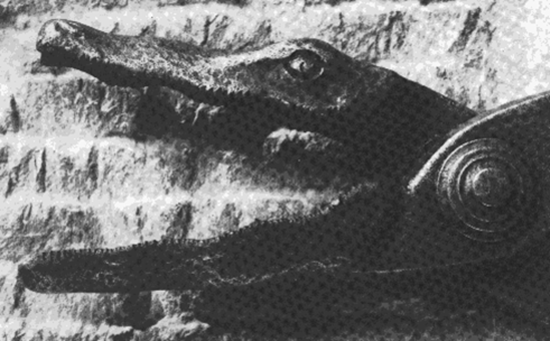
Snappy & Friends, a short animated show sponsored by Kellog's Rice Krispies, first aired sometime in 1949. In 1968, a visionary toy scientist named Alex Cartwright created an artificially intelligent robotic arm that could play full games of Stratego, Battleship, and Candyland, to the delight and vague unsettlement of its opponents. One of the defining rock bands of the hippie era was Digital Lady, an acoustic-guitar-and-kitchen-utensils ensemble that featured the brother of Richard Nixon's press secretary on percussion.
None of this is true, of course, but if you consulted Wikipedia about any of it in recent years, you'd find articles on Digital Lady and the robotic Milton Bradley Playmate that were just as detailed and seemingly well-sourced as those about musical groups and children's entertainment robots that actually exist. By its very nature, the encyclopaedia that anyone with an internet connection can edit is fertile ground for hoaxes, and because everyone from spam site webmasters on up to university professors uses Wikipedia as a source of information, many of those hoaxes multiply and persist elsewhere long after they've been flagged and removed from the site.
While researching the longest-running-hoax in Wikipedia history for a post last week, I noticed a page on Wikipedia itself devoted to fictions that have been published there in the past. Below are 10 of the strangest, cleverest, and most doggedly influential examples, all of which lasted at several years on the site before they were taken down.
1. Olimar the Wondercat, the Fake BBC Kids' Show
Published: August 5, 2006
Deleted: July 9, 2013
Olimar the Wondercat, supposedly a "short-lived children's television programme made by the BBC in the 1970s" featuring a cat with magical powers, was in fact fabricated by a British clinical neurologist named Ed Wild as a tribute to his real-life, non-magical cat, presumably also named Olimar. Wild admitted the ruse on Twitter after the Olimar page was pulled down in 2013. To lend the article credibility, Wild seems to have invented a non-existent website called "When We Were Kids TV Archive," then used that website as a source.
Choice excerpt: "Despite Derek being voiced by Serge Gainsbourg, the French version was a flop and was dropped after only four episodes."
Outside Wikipedia: Despite its seven years online, Olimar didn't break far into the wider internet. One obscure cartoon-related website places it on a list of "pre-80s" TV shows, and it appears as an entry on Free-Streaming-Movies.com. For some reason, they weren't able to find a working stream.
2. Joe Streater and the Boston College Point-Shaving Scandal
Image via Awful Announcing
Published: August 12, 2008
Deleted: October 8, 2014
The Boston College point shaving scandal is very real: ESPN produced a 30 for 30 documentary about the '78-'79 mob-affiliated bid to fix college basketball games last year. But Joe Streater, a real BC player whose name is frequently mentioned in connection with the fix, wasn't involved with it at all. In fact, he wasn't even on the team at the time. As Ben Koo conclusively documented on the blog Awful Announcing in 2014, the widespread tarnishing of Streater's name can be traced to one inaccurate Wikipedia edit that was duplicated several times over by journalists who used the encyclopaedia as a source.
Choice excerpt: ""Kuhn agreed to participate, and brought in his teammate Jim Sweeney and Joe Streater"
Outside Wikipedia: Sports Illustrated, Bleacher Report, and the Associated Press have all published sports-scandal roundups that mention Streater as a guilty party in the BC scheme. As of March 20, only Bleacher Report has issued a correction.
3. Milton Bradley Playmate, the Toy From the Future
Image: Wikipedia
Published: January 2008
Deleted: August 10, 2014
The Milton Bradley Playmate's article is unusually detailed and well-written for a hoax, which may explain how it was able to live so long despite a patently unbelievable premise. According to Wikipedia, the Playmate was a late '60s-era concept toy that never actually made it to market, which would have allowed kids to play real-life Milton Bradley board games against an intelligent robot that used a claw arm to move pieces around.
Choice excerpt: "Due to the large servo motors required to operate the claw arm and the primitive state of computing at this time, Cartwright was unable to get the Playmate to an acceptable size and cost before Milton Bradley pulled his funding. The final version of the Playmate was around the size of a filing cabinet and would have cost an estimated $5000 USD."
Outside Wikipedia: The Playmate appears in a spammy machine-generated book called Entertainment Robots, which probably pulled its text straight from the Wikipedia article. (This sort of thing happens all the time.)
4. Bilcholim Conflict, the War That Wasn't
Image via Daily Mail
Published: July 4, 2007
Deleted: December 29, 2012
The Bilcholim Conflict - a supposed 17th century war between Portugal and the Maratha Empire that led to the creation of Goa as an independent state within India - is probably the most well-known hoax on Wikipedia. The Daily Dot chronicled the 4,500-word article's story in 2013, noting that the author had invented several books and their authors to flesh it out (try googling David D'Souza's 1961 tome Roots of Conflict in Portuguese Goa). Bilcholim is also notable for its having been awarded a "good article" designation - a seal of legitimacy that the Wikipedia community only bestows upon one percent of articles on the site.
Choice Excerpt: "A 1921 fiction book by Frank McCallas on rebellion in India bore notable similarities to the events of the Bicholim conflict. Another book in 1958 by Goan writer Victor D'Souza entitled 'Goan Life' presented a story about a Christian family living in a village which had given up allegiance to the Marathas, which was possibly inspired by the events during the conflict."
Outside Wikipedia: David D'Souza's fictional book is cited as a reference on at least one non-Wikipedia blog post, and Bilcholim itself was immortalized in a bot-generated book, just like the Milton Bradley Playmate. It has been so widely publicized as a fabrication, however, that much of what you're likely to find online today makes reference to the hoax itself, not the imaginary conflict.
5. Digital Lady, the Psychedelic Kitchen-Sink Band
Image: Wikipedia
Published: December 2008
Deleted: July 12, 2014
Digital Lady, the aforementioned San Francisco experimental rock band, was supposedly borne out of its founding members' common interest in "subversion, tattoos, and The Meters." The group's records, carrying excellent titles like Lush Bum and Impeccable Creams, were "notoriously sparse; Cusmari and Wolfe recorded their EP with two acoustic guitars and a single Shure SM58 microphone. Drums were improvised using kitchen dishes and utensils." Manfred Ziegler, imaginary brother of real Nixon staffer Ron Ziegler, was the drummer.
Choice Excerpt: "Digital Lady's essence can be heard in a variety of today's bands, including The Provisionals, who covered the Digital Lady song, Girls In Green, on their first EP. Similarly, smatterings of Digital Lady can be heard here and there throughout the shoegaze genre."
Outside Wikipedia: A concert-tracking website called Zup lists Digital Lady in its database of bands. Thanks to Digital Lady, Ron Ziegler is linked to terms like Moog synthesizer and Switched-On Bach on this interactive infographic.
6. Crocodile shears, the Unbelievably Brutal Penis-Torture Gear
Published: March 20, 2006
Deleted: July 30, 2012
A medieval torture device that was supposedly used on the penises of men who attempted to assassinate a king. The shears' spiked blades were to be superheated before use. (The phrase "crocodile shears" does have a real-world connotation, but it has nothing to do with torture or penises.)
Choice excerpt: "The penis...once exposed to sufficient tension, was torn from the prisoner's body; or, at the least, was severely mutilated."
Outside Wikipedia: Crocodile shears regularly turn up on lists and discussions of "gruesome," "horrifying," and "twisted" torture devices, including on ViralNova, Listverse, AskMen, and Urban Dictionary. They're also found in several books with real, human authors, including Nigette M. Spikes' Dictonary of Torture and Alex Preston's novel In Love and War, which the Guardian called "profoundly moving" in its review last year.
7. Saint Ofelia, the Imaginary Martyr
Image: Wikipedia
Published: June 8, 2008
Deleted: April 14, 2014
Saint Ofelia, of Denmark, is said to be a Roman Catholic martyr. But it's hard to find a reference to her in any source that doesn't seem to be getting its information from her four-sentence Wikipedia article.
Choice excerpt: "Her name day is February 3."
Outside Wikipedia: References to the imaginary martyr are mostly found on baby-naming sites like this one and this one. (We can only hope some child somewhere has been named after her.) She's also in a spam book about Danish people.
8. The Made-Up Maid That Inspired Amelia Bedelia
Image via The Daily Dot
Published: January 31, 2009
Deleted: July 29, 2014
The article on Peggy Parish's series of children's books once alleged that the titular character was based on a maid in Cameroon, "where the author spent some time during her formative years." Daily Dot writer EJ Dickson admitted last year that she'd made the edit with a friend in college while they were "stoned out of our minds," "with the intention of seeing how fast it would take to get it taken down." It stayed up for five years.
Choice excerpt: "Her vast collection of hats, notorious for their extensive plumage, inspired her to write an assortment of tales based on her experiences in North Africa."
Outside Wikipedia: As Dickson notes, her tossed-off joke picked up an astounding amount of steam after she published it: here it is in a book about Jews and Jesus Christ; here, a blogger uses the fictional anecdote to make a laboured point about slavery. Herman Parish, who picked up writing the Bedelia books after the death of his aunt, once told a reporter that Peggy based "the lead character on a French colonial maid in Cameroon."
9. Slow Blind Driveway, the Inauthentic Bluesman
Published: November 16, 2006
Deleted: August 26, 2009
Slow Blind Driveway - an imaginary old guitarist dreamed up to poke fun at both the naming conventions of bluesmen and the insatiable appetite of some record collectors for ever-more impoverished and obscure musicians - was supposedly born in Jackson, Mississippi, in 1885, and recorded for Atlantic and Regal Records before his death of heart failure in 1952. His distinctive moniker was inspired by his given surname - Driver - and "the number of his songs about being on the road."
Choice excerpt: "His style was unique: a form of country blues, bridging the gap between the raw blues of the Mississippi Delta and the more refined Chicago sound. The style is documented on John Lomax's 1940 recordings of Driveway for the Library of Congress."
Outside Wikipedia: A "this day in blues history" blog post commemorates April 19 as the day "Influential Blues guitarist, singer, and songwriter, Slow Blind Driveway died in Deatsville, Alabama at the age of 66." The folk singer John Gorka occasionally performs under the name Slow Blind Driveway, though that joke appears to be unconnected to the Wikipedia hoax.









No comments:
Post a Comment
Please adhere to proper blog etiquette when posting your comments. This blog owner will exercise his absolution discretion in allowing or rejecting any comments that are deemed seditious, defamatory, libelous, racist, vulgar, insulting, and other remarks that exhibit similar characteristics. If you insist on using anonymous comments, please write your name or other IDs at the end of your message.